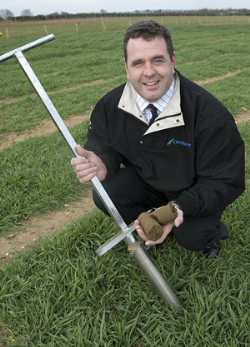
A new label recommendation for Hallmark Zeon provides wheat growers with a fully approved alternative to chlorpyrifos to tackle Orange Wheat Blossom Midge (OWBM) this summer.
Hallmark Zeon had already proven highly effective at reducing adult OWBM when used to control aphids present on the ears, where infestations coincide. Now Hallmark Zeon can be used specifically to target the midge pest at the optimum timing.
Syngenta Insecticide Manger, Bruce McKenzie believes this brings an excellent bee friendly product to target OWBM and other cereal ear insect pest infestations. However he has emphasizes the need for vigilance to ensure that OWBM is targeted near the peak of adult flight to ensure the maximum reduction of the pest.
"Many of the larvae from the massive midge attack in 2004 did not emerge last year and are still safely cocooned in the soil. If conditions are right in late May or early June this year, they will emerge with the potential to cause immense damage to susceptible varieties.
"A well-timed application of Hallmark Zeon has been shown to provide high levels of control of adult midges and break the egg-laying cycle. If growers disrupt the egg-laying activity, destructive larval feeding and grain damage can be prevented, as well as minimising larvae numbers returning to the soil."
ADAS trials under high OWBM pressure in 2004 showed a significant 60% reduction in larvae number from a single Hallmark Zeon application at the peak of adult midge activity. The timing was 6 June in the west (ADAS Rosemaund) and 10 June in the east (ADAS Boxworth).
Advice from results of the ADAS trials show the optimum time for Hallmark Zeon application is immediately the threshold numbers of adult egg-laying midges are found on the ears. ADAS entomologist, David Green, says this should be one midge or more per three ears on susceptible feed varieties, or just one midge per six ears on milling crops.
"Crops are vulnerable to attack between ear emergence and the start of flowering (GS 51 - 59), with crops at GS 53 - 57 most susceptible," he warns. "Trials have shown that Hallmark Zeon provided acceptable control, providing the applications are well timed; furthermore the cost of treatment is lower than chlorpyrifos. It offers a useful alternative option for growers."
Risk is highest in 2nd and 3rd wheat crops, on farms with a high proportion of wheat, where there has been a history of attacks and where control measures have not been successful in the past. Mr Green adds that the use of pheromone traps to identify early adult activity and in-crop sticky traps could play an important role in timing applications, along with the growth of OWBM resistant varieties to reduce the impact of pest attacks.
Bruce McKenzie highlights Hallmark Zeon provides a cost-effective, bee and spray operator friendly alternative to chlorpyrifos, at around half the price.
Results of Hallmark Zeon trials by The Arable Group, in the OWBM epidemic year of 2004, showed yield from a crop of Xi19 milling wheat increased more than 1.6 tonnes/ha over untreated, and 200 kg/ha more than chlorpyrifos treatment. The margin over treatment cost was £100 per hectare with Hallmark Zeon, compared to £80 with chlorpyrifos.
Growers do need to target the adult midges with Hallmark Zeon applications; once the larvae have hatched will prove too late advises Mr McKenzie. "Don't be tempted to delay application to coincide with T3 ear fungicides and possibly compromise the efficacy of both. Growers using a late T2/early T3 fungicide strategy may be able to integrate the two, but midge spray timing must be a priority."
Hallmark Zeon is the only pyrethroid approved for OWBM control.
